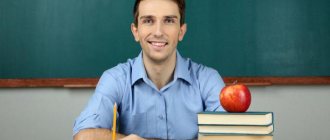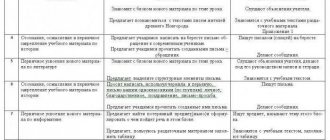Self-analysis of a literary reading lesson, grade 2
Introspection
literary reading lesson, 2nd grade
Topic: “Collective creativity “The Kingdom of Moroz Ivanovich”
Lesson objectives:
- Organization of conditions for generalizing knowledge on literary reading.
- Formation of reading skills: correctly name the work, author, genre, topic.
- Development of students' creative abilities, independence.
- Creating conditions for positive motivation for learning through literature.
Planned results:
-subject : answer questions; carry out creative projects using the knowledge and skills acquired in class; develop reading skills (determine the genre of a work)
- meta-subject (UUD):
regulatory: the ability to independently set goals, plan, control, evaluate one’s activities based on the progress and results of completing a task;
cognitive: perform actions according to a given algorithm;
communicative: create individually, in groups, stories about heroes, take into account the partner’s position, organize and carry out cooperation, agree on the procedure for working in a group;
— personal: understand the meaning of the task, give examples, evaluate the result obtained, exercise self-control, possess communication skills
Equipment: computer, projector, screen , presentations, sheets for group work, laptops, snowflakes, textbook “Literary Reading”, grade 2, part 1, author L.A. Efrosinina, Moscow, Ventana-Graf, 2014.
Lesson type: combined.
Methods: verbal, visual, practical.
Type of lesson: lesson using multimedia.
Forms: frontal, individual, group, pair work.
The literary reading lesson took place in the second grade. This topic is the final lesson of the section “The snowball flutters and spins.”
When planning this lesson, psychological and physiological
characteristics of children. The content of the lesson is developmental in nature, the cognitive activity of students increases, and the communicative qualities of the individual are cultivated. The children were active in the lesson, persistently tried to achieve results, diligently completed assignments, and checked them. During the lesson, the children developed character traits such as hard work, respect for each other, determination, and responsibility. The lesson contributed to the development of interest in literary reading lessons.
The use of various methods and forms of work aroused great interest among the children in the lesson. From the first minute, children are immersed in the activity, which helps ensure a high level of involvement and immersion in learning activities at the very beginning of the lesson. The use of crossword puzzle work on laptops at the beginning of the lesson got the children interested. This made it possible to move on to defining the topic of the lesson and ensured readiness for the next stage of work, involving the children in productive learning activities. Systematization and generalization of knowledge in the section “The snowball flutters and spins” took place in the form of work with interactive tasks on the website LearningApps.org .
The lesson develops mental activity: the ability to analyze, compare, classify and draw conclusions. Throughout the lesson, the formation of the UUD takes place. Regulatory learning skills include children’s skills: to accept and maintain an educational task, to plan necessary actions. Cognitive UUDs include performing actions according to an algorithm . The following communicative skills are formed: the ability to enter into dialogue with classmates, participate in a general conversation, observing the rules of speech behavior, the ability to listen to classmates, and formulate one’s own thoughts. There is a formation of personal UUD - a positive attitude towards cognitive activity . In the lesson, subject-specific UUDs are formed: the ability to find answers to the teacher’s questions, relying on previously acquired knowledge.
Writing a fairy tale contributed to the development of children's creative abilities, enriching their vocabulary, and the desire to more accurately express their own opinions and positions. The use of computer technology in the classroom made it possible for children to holistically perceive new material and to build a visual range of what they perceive.
The clarity and sequence of all stages of the lesson can be traced. All stages of the lesson corresponded to the nature of the students’ cognitive activity. The proposed tasks and all types of work were both developmental and educational in nature. The material was large in volume. The children did not experience great difficulties in completing the tasks. The children worked in pairs and groups, which allowed both students with a high level of development and “weak” children to get involved in the work.
The order and discipline of students in the lesson was supported by organization, interesting material, and the degree of correctness of the teacher in relation to children. Children's activity was welcomed and independence was encouraged. A friendly tone and the ability to control intra-collective relationships allowed all children to feel comfortable in the lesson.
A special aspect of the lesson had a health-saving effect: I am friendly towards children, I strive to create a situation of success, therefore I believe that we have an atmosphere of mutual understanding with the children, the children work in conditions of psychological comfort, when each child is successful in his opinion, he is not afraid to speak out. In order to prevent fatigue, I conducted a musical physical exercise and alternated various types of activities.
The content of the lesson complied with the requirements of the Federal State Educational Standard. The lesson plan is completely completed; The lesson achieved its goals, which is confirmed by the students’ conscious answers to the final questions of the lesson.
Detailed self-analysis of an open lesson on reading in 2nd grade
Self-analysis of an open lesson on reading and speech development in grade 2.
The lesson was conducted on November 22 by teacher G.S.
Berdnik. Lesson topic: Introduction to the topic “Birds are our friends” I. Sokolov-Mikitov “Nightingale”.
The lesson summary can be viewed here /blogs/galina-stanislavovna-berdnik/konspekt-otkrytogo-uroka-po-chteniyu-vo-2-klase-na-temu-pticy-nashi-druzja.html
Objectives : To introduce students to Sokolov’s new story Mikitova. To form a natural interest in our smaller brothers, to expand and deepen children’s knowledge about nature, in particular about birds. Develop reading skills, working with text, phonemic hearing, visual perception, attention. Fostering a caring attitude, love for nature, caring for our little brothers. The author and compiler of the textbook for grade 2 is S.Yu. Ilyina. I chose this textbook because the texts here are given in accordance with the development of our students, our class. Section “Birds are our friends”, an excerpt from the work of I.S. Sokolov-Ilyinsky "Nightingale". In total, 7 hours are allotted for the section, 1 hour for this work. This lesson is an introductory lesson to studying the section. Lesson type – combined lesson, i.e. combining the types of work and tasks of several types of lessons. In accordance with the type of lesson, the following structure is provided for its delivery: 1. Organizational beginning of the lesson. 2. Articulation gymnastics. 3. Statement of the topic and purpose of the lesson. 4. Studying new material. 5. Physical education minute. 6. Work on the text. 7. Relieving eye tension. 8. Corrective task. 9. Lesson summary. 10. Homework. Related tasks: development of oral speech skills, the ability to reason and find the main idea in the text. Every teacher dreams of introducing his students to the study of his subject, wants to see them more developed and inquisitive. Everyone knows well how difficult it is to instill in students the need to explore interest in it. The problem of maintaining interest in the subject worries me too. To maintain interest and motivate students to study it, I consider it insufficient to use only the educational materials provided by the program. Therefore, I am trying to go beyond it and use in my teaching activities the accumulated knowledge and methodological techniques, not only my personal ones, but also those of other teachers. First of all, the lesson was compiled based on the characteristics of the students in this class. The lesson is structured in accordance with program requirements. The principle of complexity was also taken into account, which involves interconnected teaching of speech activity. In addition, the psychological and educational characteristics of students in this class were taken into account (i.e., a differentiated approach was implemented). Children in this class poorly perceive educational material. They cannot work without a teacher, they are distracted, they are undisciplined in class, they do not know how to control their behavior, they require control from the teacher. They do not know how to abstract themselves; it is difficult to analyze new material. Mental processes such as memory and thinking are poorly developed. They are not interested in additional sources of knowledge. The exercises are performed according to a model, they cannot cope with creative tasks on their own, the motivation is very weak. They teach the rules, but often do not understand the meaning, so there are difficulties in applying them in practice. On the educational side, when preparing for the lesson, I tried to include a variety of teaching techniques and methods. Combined individual, frontal and group work. At each stage of the lesson, certain goals were achieved, and students were involved in reviewing their answers. The following teaching methods are used in the lesson: 1. According to the source of transmission and the nature of perception: – verbal (teacher’s story, conversation, children’s messages); – visual (illustrations, explanatory dictionary, toys); – practical (working with newspaper material, working with handouts, working with signal cards or a book). 2. By the nature of cognitive activity: – explanatory and illustrative; – heuristic (partially search); – reproductive. In addition, teaching techniques are used that form and activate individual operations of thinking, attention, memory, imagination (game techniques: “Say a word”, “Decipher the word”, guessing riddles) that contribute to the creation of search situations in the process of students’ mental activity (“brainstorming”) ", creating a situation of cognitive search, predicting the topic of the text); techniques that activate students’ emotions (“psychological moments” at the beginning and end of the lesson, the technique of personal significance - at the stage of reflection, the use of a fairy tale plot); control techniques (non-verbal – teacher observation, frontal questioning). Taking into account the psychological and age characteristics of children of primary school age, the following technologies were included: – health-saving (physical education breaks, play moments, relieving eye strain); – developmental learning (the presence of logical connections in the structure of the lesson: from general to specific, from abstract to concrete, from difficult to easy, from unfamiliar to familiar); – problem-based learning; – use of gaming methods; – learning in cooperation (working in pairs). During the lesson, at the main stages, summing up is carried out in the form of a survey. Complete the sentence “Today in class I learned that...”. “Today in class I was interested because...” Particular attention is paid to the reflection stage: “Remember all the moments of our lesson and tell me what you liked the most?” We evaluate the productivity of the lesson together with the children - we choose hearts of different colors. From an educational point of view, the lesson contributed to the development in children of an interest in reading large works, a positive attitude towards people and the world around them. I believe that favorable socio-psychological and aesthetic conditions for learning were created during the lesson. The lesson has achieved its objectives.
We recommend watching:
Self-analysis of an open lesson in mathematics in grade 2. Notes of an open lesson on reading in grade 2 with presentation. Notes of a reading lesson in grade 2. Notes of a reading lesson for grade 2 of a special (correctional) school of the VIII type.
Similar articles:
How to conduct a lesson analysis
Self-analysis of the lesson on the Federal State Educational Standard



